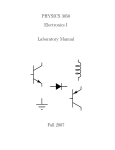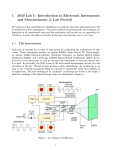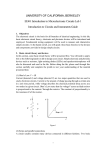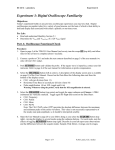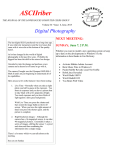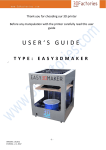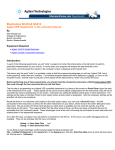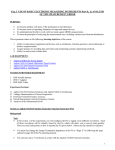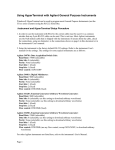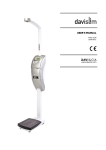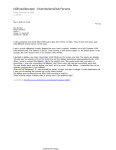Download PHYSICS 3050 Electronics I Laboratory Manual Fall 2007
Transcript
PHYSICS 3050 Electronics I Laboratory Manual Fall 2007 Contents 1 3050 Lab I - Introduction to Electronic Instruments and Measurements (1 Lab Period) 1 1.1 The Instruments . . . . . . . . . . . . . . . . . . . . . . . . . . . . . . . . . 1 1.2 Using the DSO and Function Generator . . . . . . . . . . . . . . . . . . . . . 2 1.3 Using the DC Power Supply and the DMM . . . . . . . . . . . . . . . . . . . 3 2 3050 Lab II - Simple Passive Networks (1 Lab Period) 4 2.1 Voltage Division . . . . . . . . . . . . . . . . . . . . . . . . . . . . . . . . . . 4 2.2 Thévenin Equivalent Circuits . . . . . . . . . . . . . . . . . . . . . . . . . . 4 3 3050 Lab III - Filters (1 Lab Period) 6 3.1 The Fast Fourier Transform (FFT) Feature on the DSO . . . . . . . . . . . . 6 3.2 The Low-Pass RC Filter, Part I . . . . . . . . . . . . . . . . . . . . . . . . . 6 3.3 Introduction to LabVIEW . . . . . . . . . . . . . . . . . . . . . . . . . . . . . 7 3.4 The Low-Pass RC Filter, Part II . . . . . . . . . . . . . . . . . . . . . . . . . 7 4 3050 Lab IV - Introduction to Diodes (1 Lab Period) 8 4.1 Testing the Diode . . . . . . . . . . . . . . . . . . . . . . . . . . . . . . . . . 8 4.2 Reverse-biased Diode Circuit . . . . . . . . . . . . . . . . . . . . . . . . . . . 8 4.3 Forward-biased Diode Circuit . . . . . . . . . . . . . . . . . . . . . . . . . . 9 4.4 Germanium and Zener Diodes . . . . . . . . . . . . . . . . . . . . . . . . . . 9 4.5 Diode Characteristics . . . . . . . . . . . . . . . . . . . . . . . . . . . . . . . 9 4.6 The Light Emitting Diode (LED) . . . . . . . . . . . . . . . . . . . . . . . . 10 5 3050 Lab V - Introduction to Transistors (1 Lab Period) 11 5.1 Testing Transistors . . . . . . . . . . . . . . . . . . . . . . . . . . . . . . . . 12 5.2 DC Transistor Characteristics . . . . . . . . . . . . . . . . . . . . . . . . . . 12 i 6 3050 Lab VI - The Transistor as a Switch (1 Lab Period) 14 6.1 Rise and Fall Times . . . . . . . . . . . . . . . . . . . . . . . . . . . . . . . . 14 6.2 A NOT gate . . . . . . . . . . . . . . . . . . . . . . . . . . . . . . . . . . . . 15 7 3050 Lab VII - The Common Emitter Amplifier (1 Lab Period) 16 7.1 Biasing the Amplifier . . . . . . . . . . . . . . . . . . . . . . . . . . . . . . . 16 7.2 Amplifier Gain and Frequency Response . . . . . . . . . . . . . . . . . . . . 16 ii Introduction, Lab Safety, and Circuit Building Tips In the PHYS3050 lab we will learn how to construct circuits on breadboards with passive elements like the resistor and capacitor as well as the basic semiconductor PN Junction devices – the diode and transistor. General Plan of the Lab The experiments in this laboratory will steadily require more individual work on your part. Many of the experiments will be outlined in detail but some will require you to “fill in the gaps” and to use your own initiative to select the proper components. A demonstrator will normally be available to give you advice and assistance when required, but you are expected to make an attempt to solve the problems that arise before soliciting such assistance. Lab Records and Reports Students should be aware of the importance of recording ALL the details of a laboratory experiment. If, for some reason, you find inexplicable results upon the analysis of your data at home, you should be able to make an educated guess as to what went wrong from reviewing your lab records. Every experiment carried out in the laboratory must be recorded and reported. Your record of each experiment should be considered a full outline of the laboratory work on that experiment so that, if required, you could use it as a basis for writing a formal report when away from the laboratory. Your report should include the following: • title, student’s name, date. • brief statement of the principle of the observations. • the different exercises clearly labeled in each experiment. • equipment specified either through a serial number or some other distinctive marking for that instrument. • complete circuit diagram. • exact record of your experimental procedure. • tables of any data plotted in a graph (with units!). • graphs of the observations, when required. • brief note on sources of errors. iii • conclusions and discussion, including comparisons with “theoretical” expectations, if relevant. Graphs play an important role in the record and the report since they often make certain results and trends clear which may not be apparent in the tabulated data. A picture is worth a thousand ... numbers. The axes of each graph should be fully labeled (with units!), and each graph should have a title and a legend. Graphs should normally be on separate pages from the text, should always be on the appropriate graph paper, and preferably should be located near the corresponding description in the text of the report. After completing your experiments, you must have all the tabulated data in your own notebook and it must be presented to your demonstrator for his/her signature. Each experiment must be submitted to your lab demonstrator for marking at the beginning of your next lab period (both the first and the final lab reports are due one week after completion of the lab and should be dropped off at a place specified by your demonstrator). Thus, you will need two bound notebooks to contain your lab reports. Neither typing of the lab reports nor usage of a hardcover lab book is required. Reports will be graded on quality, not quantity. Your preparation time will be reduced if you try to be concise, but complete. Late reports will be accepted up to four days beyond the assigned due date. A penalty of 25% per work day late will be applied. After four days late the report will not be accepted. Lab Safety Electrical equipment and circuits can be dangerous if you are not fully aware of the potential hazards. Operating manuals and instruction for using the equipment in the lab are available from the lab demonstrator. Make sure that you are familiar with the equipment before turning it on. The chief sources of electric power in the lab are the 110 V AC power outlets in the walls, extension cords and consoles, and the DC power supplies. Much higher voltages occur inside some units (e.g., > 14 kV in the oscilloscope) but these are ordinarily protected by the cover plates. Do not stick your fingers inside an instrument when the power is on. Even given that, remember that it is current through your body that is dangerous. The magnitude of the current through your body depends on your body resistance but the damage it does to you depends on the current path through your body. A current path from one hand through your body and out the other hand is far more dangerous to you than current that enters through one finger and exits out the next finger. Therefore, it is common practice to keep one hand behind your back when dealing with hazardous electrical systems. The physiological effects of current are given below. iv THE FATAL CURRENT Reprinted through the courtesy of Fluid Controls Company, University of California, Safer Oregon 1.0 Strange as it may seem, most fatal electric shocks happen to people who should know better. Here are some electromedical facts that should make you think twice before taking that last chance. Severe Burns Breathing Stops IT'S THE CURRENT THAT KILLS Offhand it would seem that a shock of 10,000 V would be 0.2 DEATH more deadly than 100 V. But this is not so! Individuals have been electrocuted by appliances using ordinary house 0.1 Extreme Breathing Difficulties currents of 110 V and by electrical apparatus in industry using as little as 42 V direct current. The real measure of electrical device used on a house wiring circuit can, under certain conditions, transmit a fatal current. Breathing Upset Labored SevereShock Muscular Paralysis Amperes shock's intensity lies in the amount of current (amperes) forced through the body, and not the voltage. Any Painful While any amount of current over 10 mA is capable of 0.01 Mild Sensation producing painful to severe shock, currents between 100 and 200 mA are lethal. Currents above 200 mA, while producing severe burns and unconsciousness, do not usually cause death if the victim is given immediate attention. Resuscitation, consisting of Threshold of Sensation artificial respiration, will usually revive the victim. 0.001 From a practical viewpoint, after a person is knocked out by an electrical shock it is impossible to tell how much Physiological Effects of Electrical Currents current passed through the vital organs of their body. Artificial respiration must be applied immediately if breathing has stopped. The internal resistance of your body (right hand to left hand or, hand to leg) is typically around 500 Ω. In series with this is the surface resistance of your skin which varies from 1000 Ω when moist to over 100 kΩ when dry. Thus a voltage as low as 50 V can be v dangerous if your hands are wet. Hence, never work with electrical equipment when your hands or clothing are wet. Lab Etiquette Be careful not to damage any of the measuring equipment and try to avoid breaking the components. We need them for other students in other lab periods in this course. You should report equipment/component faults promptly to the demonstrator. You should never set aside faulty equipment without reporting it. Furthermore, you should not attempt to repair faulty equipment yourself. Return all components and equipment to the proper location at the end of each lab period. Equipment, components, and operation manuals may not be removed from the lab under any circumstances. You are not permitted to work in the laboratory outside of regular laboratory periods, unless special authorization is obtained and a lab demonstrator is present. Food and drink are not allowed in the lab at any time. If you are hungry or thirsty feel free to leave the lab and take a short break. Circuit Building Tips Much of the lab equipment you will work with is expensive and delicate. Therefore, to save the equipment and also to reduce the amount of time you waste using faulty equipment and components, here are a few random tips associated with doing experiments in the lab: • Build up the circuit in steps, checking each element before you use it. • Never wire a circuit with the power supply on. • Turn off the input voltage and then the power supply when changing a circuit element. • Keep in mind the power rating of the resistors being used and the polarity (if relevant) of the capacitor. When using semiconductor devices like diodes and transistors, remember that the maximum current they can transmit is something like 40 mA. So care must be taken to make sure that resistors are added properly so as to ensure that the component is not required to pass larger currents. The elements will burn – they are not expensive but you will waste a lot of time if it turns out one of the components in your circuit has burned out. vi 1 3050 Lab I - Introduction to Electronic Instruments and Measurements (1 Lab Period) The purpose of this experiment is to familiarize you with the electronic instruments that will be required for future experiments. The proper methods of measurements and technique are important in all experimental work and this experiment will provide you an opportunity to ’brush-up’ on some the skills you learned in the past and introduce you to new ones. 1.1 The Instruments Each pair of students has a suite of instruments for performing the experiments for this course. Those instruments include: an Agilent E3630A Triple Output DC Power Supply, an Agilent 33120A Function/Arbitrary Waveform Generator, an Agilent 34401A Digital Multimeter (DMM), and a Tektronix TDS200 Digital Storage Oscilloscope (DSO). In the first part of the experiment we will go through each instrument in turn and discuss how it is used. In particular, the DSO is one of the most useful measurement devices you will encounter in the lab. Though at first perhaps a little intimidating, the oscilloscope is an easy to use, versatile instrument which you should be comfortable using and confident of its application. The basic workings of an “analogue” oscilloscope are shown in the Figure 1 while the workings of the Digital Storage Scope are illustrated in Figure 2. Figure 1: An Analogue Oscilloscope. 1 Figure 2: The Digital Storage Oscilloscope. Concepts you should learn about the DSO are: – fundamental oscilloscope operation including use of MENUs – grounding considerations – the function of the AC-GND-DC coupling – oscilloscope triggering 1.2 Using the DSO and Function Generator Connect the Function Generator to CH1 of the DSO using a cable with BNC connectors at both ends. First generate a sine wave having a frequency in the 10’s of kHz range and an amplitude that is some multiple of 100 mV (see page 19 of the Agilent 33120A Function Generator User’s Guide). Also, add a DC offset of 100 to 200 mV. On the DSO, adjust the “sec/div” knob to see two complete cycles of the waveform on CH1. Use the CH1 menu to set the Coupling, BW Limit, Volts/Div, Probe, and Invert values (see page 89 of the TDS 200-Series Digital Real-Time Oscilloscope User Manual). What values did you choose and why did you choose them? Use the TRIGGER menu to set the Trigger mode to Edge. Set the Slope, Source, Mode and Coupling values and adjust the Trigger Level. Again, what values did you choose and why did you choose them? With the DSO in DC-coupled mode, select the MEASURE menu. Check what happens to the menu display when you select Source or Type. Measure the following values using the menu buttons. 1. Frequency 2 2. Pk-Pk Voltage 3. Mean Voltage 4. Period Are these values consistent with the settings on your function generator? Do they change if you change to AC coupling on the DSO? Repeat the steps in this section for a square wave, triangular wave, and sawtooth wave. 1.3 Using the DC Power Supply and the DMM Grab a couple of resistors from the pile provided. Record the band structure of the resistors and measure their resistance using the DMM. [For your report: How close are they in value to what the bands indicate they are? Is this what you would expect?] Connect the resistors in series on a bread-board (also called a proto-board) and measure the resistance of the pair. Now use the Power Supply to apply around 2 V DC across the pair. Draw completely how you set up the circuit including where is the common ground point of the Power Supply. Measure and record the potential drop across each resistor in turn using the DMM. Measure the current through the resistors. Show exactly how you performed the measurements. What did you expect the results to be and did you find this to be the case? Perform the voltage measurements again using the DSO rather than the DMM. Now remove the DC Power Supply and connect the square-wave signal from section 1.2 across the pair of resistors. Repeat the measurements of the previous paragraph, again making sure to show how each measurement was made. Compare the values from the MEASURE Menu on the DSO with the measurement from the DMM. Are they consistent? 3










